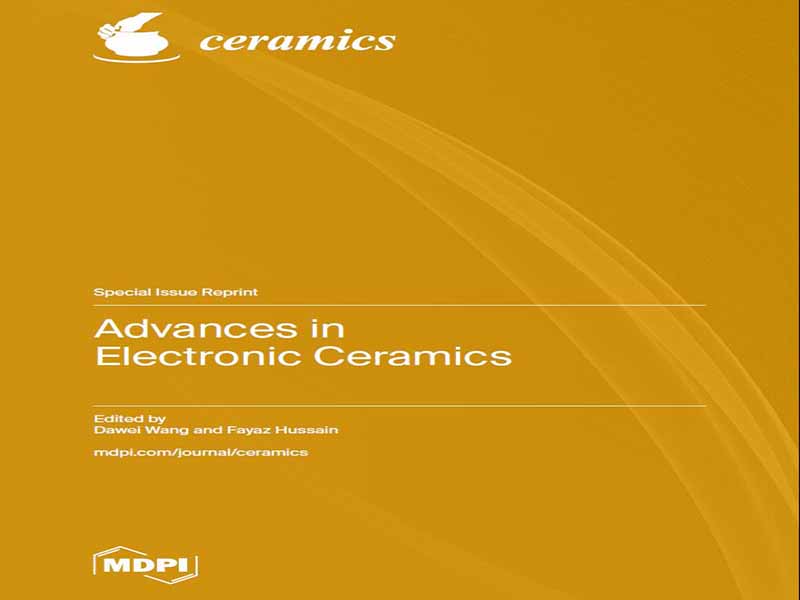- عنوان: Advances in Electronic Ceramics
- نویسنده: Dawei Wang, Fayaz Hussain
- حوزه: تولید برق
- سال انتشار: 2025
- تعداد صفحه: 230
- زبان اصلی انگلیسی
- نوع فایل: pdf
- حجم فایل: 10.8 مگابایت
لایههای نازک فروالکتریک خواص متنوعی مانند فروالکتریسیته، پیزوالکتریسیته، دیالکتریک، پیروالکتریسیته و اثرات فوتوالکتریک از خود نشان میدهند که آنها را برای کاربردهای مختلف از جمله حافظه فروالکتریک، درایورهای پیزوالکتریک، آشکارسازهای مادون قرمز و دستگاههای اپتوالکترونیک مناسب میکند [1-5]. مواد فروالکتریک سنتی، که عمدتاً ترکیبات مبتنی بر سرب هستند، به دلیل ویژگیهای فروالکتریک و پیزوالکتریک قوی خود، با تیتانات زیرکونات سرب (PZT) که به طور گسترده در کاربردهای تجاری استفاده میشود، نمونهای از این مواد هستند [6،7]. با این حال، نگرانیهای زیستمحیطی و بهداشتی ناشی از تبخیر سرب در مواد مبتنی بر سرب، بررسی جایگزینهای بدون سرب را ضروری میسازد. تیتانات مبتنی بر بیسموت و فریت بیسموت به عنوان کاندیداهای امیدوارکننده برای مواد پیزوالکتریک بدون سرب ظاهر میشوند. قابل ذکر است که تیتانات بیسموت (Bi4Ti3O12، BIT) خواص مطلوبی از جمله میدان اجباری کوچک، چگالی جریان نشتی کم، مقاومت عالی در برابر خستگی و قابلیت کاربرد در حافظه غیرفرار را نشان میدهد [8-10]. BIT، که به عنوان یک ماده فروالکتریک لایهای بیسموت (BLSF) سه لایه معمولی طبقهبندی میشود، از یک لایه اکسید بیسموت (Bi2O3)2+ و یک لایه پروسکایت مانند (An−1BnO3n+1)2− در امتداد محور c تشکیل شده است [11،12]. BIT که با ناهمسانگردی قوی مشخص میشود، قطبش خودبهخودی تقریباً 50 میکروکولوم بر سانتیمتر مربع در امتداد محور a و 4 میکروکولوم بر سانتیمتر مربع در امتداد محور c را نشان میدهد. علاوه بر این، دارای دمای رسوب فیلم پایین و دمای کوری بالا (Tc = 675 درجه سانتیگراد) است [13،14]. با وجود خواص مطلوب، BIT با چالشهایی مانند بیثباتی در حالت اکسیداسیون یونهای Ti و فراریت در یونهای Bi در طول فرآیند تفجوشی مواجه است. این مسائل منجر به نقص، در نتیجه جریان نشتی بالا و پین شدن دامنه میشود و در نتیجه بر کاربردهای عملی آن تأثیر میگذارد [9،15]. برای افزایش خواص فروالکتریک آن، محققان جایگزینی یونهای Bi3+ را در لایه شبه پروسکایت (Bi2Ti3O12)2+ با یونهای سه ظرفیتی عناصر خاکی کمیاب مانند Pr3+، Nd3+، Sm3+، Eu3+ و La3+ بررسی کردهاند [1،16-19]. در سال 1999، پارک و همکارانش یک لایه نازک فروالکتریک از BIT آلاییده شده با La، Bi3.25La0.75Ti3O12 (BLT) گزارش کردند [11]. وو و همکارانش نشان دادند که اعمال تنش کششی یا فشاری بر سطح لایههای نازک BLT در ناحیه میدان بالا (>75 کیلوولت بر سانتیمتر) به طور مؤثر جریان نشتی را کاهش میدهد [20]. علاوه بر این، جایگزینی کاتیونهای با ظرفیت بالا به جای Ti4+ در جایگاه B، در حذف نقصهای جای خالی اکسیژن، در نتیجه افزایش قطبش پسماند و کاهش جریان نشتی، مؤثر است. لایههای نازک BIT که با Sm و Ta آلایش شدهاند و به عنوان BSTTO شناخته میشوند، خواص فروالکتریک به طور قابل توجهی بهبود یافتهای را نشان میدهند و در مقایسه با لایههای نازک BIT (2Pr = 46.2 μC/cm2) [21]، قطبش پسماند بالاتری (2Pr = 26 μC/cm2) دارند. تکنیکهای مختلفی، از جمله رسوب لیزر پالسی (PLD) [22]، کندوپاش مگنترون (MS) [23]، رسوب بخار شیمیایی فلز-آلی (MOCVD) [24] و روش سل-ژل [25]، برای تهیه لایههای نازک فروالکتریک BLT به کار گرفته شدهاند. در میان این روشها، فرآیند سل-ژل به دلیل مقرون به صرفه بودن، کنترل آسان استوکیومتری و رسوب یکنواخت در سطوح بزرگ، برجسته است و آن را برای کاربردهای گسترده، مناسب میسازد. نکته قابل توجه این است که عواملی مانند محلول پیشساز، شرایط پخت، ضخامت لایه و خواص زیرلایه تأثیر قابل توجهی بر جهتگیری لایه دارند [25-27]. ضخامتهای بهینه لایه لایه 30، 50 و 100 نانومتر به ترتیب با لایههای نازک ترجیحی جهتدار با جهتگیریهای (001)، (100) و (117) مطابقت داشتند [28]. یانگ و همکارانش با تنظیم اندازه دانه BLT از طریق مدولاسیون دمای پخت، به چگالی ذخیرهسازی انرژی بالاتری دست یافتند و لایههای نازک فروالکتریک BLT را برای دستگاههای ذخیرهسازی با چگالی انرژی بالا مناسب کردند و در نتیجه دامنه کاربرد آنها را گسترش دادند [29]. علاوه بر این، فناوری ذخیرهسازی اطلاعات به عنوان یکی از سریعترین زمینههای در حال پیشرفت در حوزه مدارهای مجتمع شناخته میشود. در میان اجزای آن، حافظه به عنوان هسته محوری در فناوری ذخیرهسازی اطلاعات قرار دارد. با این حال، دستگاههای ذخیرهسازی مرسوم به نقطهای رسیدهاند که دیگر نمیتوانند نیازهای رو به رشد فناوری ذخیرهسازی اطلاعات را برآورده کنند. در نتیجه، تلاش برای توسعه نسل جدیدی از ممریستورها در سالهای اخیر مورد توجه دانشگاهیان قرار گرفته است. توسعه مواد فروالکتریک با ویژگیهای سوئیچینگ مقاومتی، اهمیت قابل توجهی برای ممریستورها دارد. در این مطالعه، لایههای نازک BLT بدون سرب با استفاده از روش سل-ژل سنتز شدند و تنظیم زمانهای پوششدهی چرخشی، لایههای نازک BLT با خواص فروالکتریک استثنایی را به دست داد. ویژگیهای دیالکتریک و فروالکتریک لایههای نازک تحت زمانهای پوششدهی چرخشی مختلف، به طور سیستماتیک در شدتها و فرکانسهای مختلف میدان الکتریکی مقایسه شدند. فروالکتریک میکروسکوپی لایه BLT و تکامل میکروسکوپی دیواره دامنه لایه BLT از طریق مشاهده PFM مورد مطالعه قرار گرفت. مشخصه مقاومت
Ferroelectric thin films exhibit diverse properties, such as ferroelectricity, piezoelectricity, dielectricity, pyroelectricity, and photoelectric effects, rendering them suitable for various applications including ferroelectric memory, piezoelectric drivers, infrared detectors, and optoelectronic devices [1–5]. Traditional ferroelectric materials, predominantly lead-based compounds, are exemplified by the widely used lead zirconate titanate (PZT) in commercial applications due to their robust ferroelectric and piezoelectric characteristics [6,7]. However, the environmental and health concerns arising from the volatilization of lead in lead-based materials necessitate the exploration of lead-free alternatives. Bismuth-based titanate and bismuth ferrite emerge as promising candidates for lead-free piezoelectric materials. Notably, bismuth titanate (Bi4Ti3O12, BIT) exhibits favorable properties, including a small coercive field, a low leakage current density, excellent fatigue resistance, and applicability in non-volatile memory [8–10]. BIT, classified as a typical three-layer bismuth layered ferroelectric (BLSF) material, consists of a bismuth oxide layer (Bi2O3)2+ and a perovskite-like layer (An−1BnO3n+1)2− along the c-axis direction [11,12]. Characterized by strong anisotropy, BIT demonstrates spontaneous polarization of approximately 50 μC/cm2 along the a-axis and 4 μC/cm2 along the c-axis. Additionally, it features a low film deposition temperature and a high Curie temperature (Tc = 675 ◦C) [13,14]. Despite its favorable properties, BIT faces challenges such as instability in the oxidation state of Ti ions and volatility in Bi ions during the sintering process. These issues lead to defects, resulting in a high leakage current and domain pinning, thereby affecting its practical applications [9,15]. To enhance its ferroelectric properties, researchers have explored the substitution of Bi3+ ions in the perovskite-like layer (Bi2Ti3O12)2+ with trivalent rare-earth ions such as Pr3+, Nd3+, Sm3+, Eu3+, and La3+ [1,16–19]. In 1999, Park et al. reported a ferroelectric thin film of La-doped BIT, Bi3.25La0.75Ti3O12 (BLT) [11]. Wu et al. demonstrated that the application of tensile or compressive stress on the surface of BLT thin films in the high-field region (>75 kV/cm) effectively mitigates the leakage current [20]. Furthermore, substituting high-valent cations for Ti4+ at the B site proves instrumental in eliminating oxygen vacancy defects, thereby enhancing remanent polarization and reducing the leakage current. BIT thin films co-doped with Sm and Ta, denoted as BSTTO, exhibited markedly improved ferroelectric properties, boasting a higher remanent polarization (2Pr = 46.2 μC/cm2) compared to BIT thin films (2Pr = 26 μC/cm2) [21]. Various techniques, including pulsed laser deposition (PLD) [22], magnetron sputtering (MS) [23], metal–organic chemical vapor deposition (MOCVD) [24], and the sol–gel method [25], have been employed for the preparation of BLT ferroelectric thin films. Among these, the sol–gel process stands out for its cost-effectiveness, facile stoichiometry control, and uniform deposition over large areas, making it versatile for widespread applications. Notably, factors such as the precursor solution, annealing conditions, film thickness, and substrate properties exert substantial influence on film orientation [25–27]. Optimal film layer thicknesses of 30, 50, and 100 nm corresponded to preferentially oriented thin films with (001), (100), and (117) orientations, respectively [28]. By adjusting the grain size of BLT through annealing temperature modulation, Yang et al. achieved a higher energy storage density, rendering BLT ferroelectric thin films suitable for high-energy-density storage devices, thereby expanding their application scope [29]. In addition, information storage technology stands as one of the most rapidly advancing fields within the realm of integrated circuits. Among its components, memory stands as the pivotal core in information storage technology. However, conventional storage devices have reached a point where they can no longer meet the burgeoning demands of information storage technology. Consequently, the pursuit of developing a new generation of memristors has captured academic interest in recent years. The development of ferroelectric materials with resistive switching characteristics holds significant importance for memristors. In this study, lead-free BLT thin films were synthesized using the sol–gel method, and the adjustment of spin coating times yielded BLT thin films with exceptional ferroelectric properties. The dielectric and ferroelectric characteristics of thin films subjected to varying spin coating times were systematically compared across different electric field strengths and frequencies. The microscopic ferroelectricity of the BLT film and the microscopic evolution of the domain wall of the BLT film were studied through PFM observation. The resistor characteristics of the BLT4 thin film were studied, demonstrating its potential application in memristor.
این کتاب را میتوانید بصورت رایگان از لینک زیر دانلود نمایید.
Download: Advances in Electronic Ceramics



































نظرات کاربران